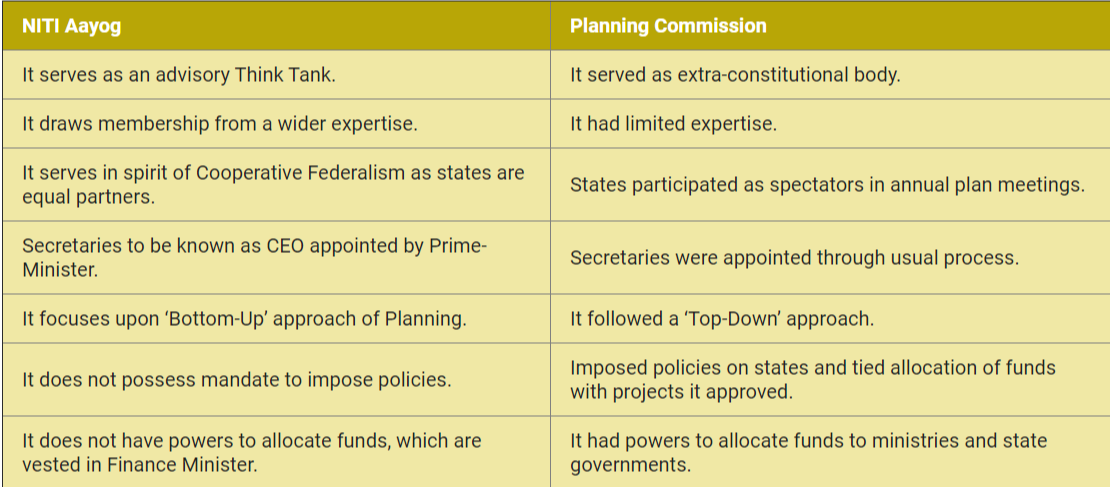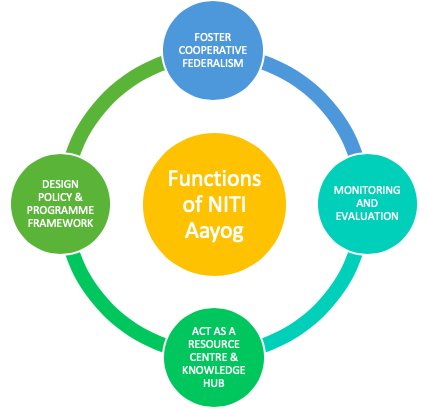Planning In India
This article is based on “Thinking national, acting local” which was published in The Hindu on 02/04/2020. It talks about the scenario of national planning in India.
Being a developing country, India needs to increase employment and incomes; revive investments and growth; untangle the financial sector; navigate muddied-up international trade; solve the perennial problems of poor education and health, and the growing problems of environmental pollution and water scarcity.
With scarce resources and a huge magnitude of welfare to be done, the role of planning becomes significant. In India the role of planning activities was played by the Planning Commission (until 2014), afterwards NITI Aayog, a policy Think Tank replaced Planning Commission with an aim to make planning approach more inclusive and bottom-up.
The charter of NITI Aayog describes it as a body that should act as a catalyst of change in India's federal and complex socio-economic system.
However, the experts have raised concerns regarding the independence of NITI Aayog to guide the government and becoming a mouthpiece of the government and an implementer of the government’s projects.
Issues Faced by National Planning
Complex-System Problem
- Economy is a complex system, as economy, human society and natural environment are intimately connected to each other.
- A feature of complex systems, in which all the parts are connected, is that the system cannot be healthy if any part becomes very sick. Further, fixing one part of the system alone can make matters worse.
- For example, providing skills to millions of youth before there are enough employment opportunities is a bold fix that can backfire.
- Similarly, this can be seen in the air pollution problem in northern India which emanates from stubble burning.
- Thus, the complexity of the task demands a good plan and a good strategy.
Severe Air Pollution Due to Stubble Burning
- The improvement of productivity of agriculture with mechanization, and the management of water resources, has produced the unintended consequence of Delhi becoming the most polluted city in the world.
- Ever since mechanization was introduced in the 1980s to improve farm productivity, farmers in Punjab have burned the paddy stubble left by machines.
- Later, alarmed by the increasing demand of water for paddy growth which was dwindling groundwater resources, the government passed the Preservation of Subsoil Water Act in 2009.
- It stipulated that farmers postpone by one month the sowing and transplanting of paddy so that it was closer to the onset of the monsoon.
- This reduced the need for drawing underground water for the transplanted paddy.
- However, the post-harvest burning of the stubble also got postponed by a month.
- It now coincided with the onset of winter in the North, when wind movement is low and atmospheric moisture content is high. Thus, it gave rise to severe air pollution in Northern India.
Federal Issue
- In India, States are expected to improve human development, create infrastructure, and make it easy to do business.
- Along with that they are expected to manage their financial resources efficiently and balance their budgets.
- However, the majority of States in India are not financially self-sufficient and most of the time that has to depend on grants from the centre, as decided by the Finance Commission (where states have no representation).
- Further, it is argued that policies formulated by NITI Aayog are based on 'One size fits all approach', most of the time they are unaware of ground realities and have little experience of how to get things done to produce outcomes.
Need for Diversification in Policy Making
- A national planning institution must guide all-round progress. It must assist in achieving not just faster economic growth, but also more socially inclusive, and more environmentally sustainable growth. For this, it needs a balanced model in which societal and environmental forces are integrated.
- However, economists have been advising policymakers to have comprehensive models of socio-environmental systems.
- This can be testified by the fact that, despite economic growth, inequality and unemployment are rampant in India.
Planning by an Executive Body
- NITI Aayog does not have constitutional status independent from that of the government, thus it is alleged to bend to the will of the Government.
Way Forward
- NITI Aayog should act as a force for persuasion, not control centre. Its role should intend to promote local systems solutions to national problems.
- Many stakeholders must be involved in the implementation of a plan in a large, diversified and democratic country. Thus, planning should be devolved to State governments, and even to the third tier of city and district governance.
- Indian Planning scheme requires a transformational approach to deal with 21st century challenges.
- It requires new methods to speed up ‘organisational learning’ amongst stakeholders in the system who must make plans together and implement them together.
- Thus, it is not good enough to have a plan, there must also be a strategy for its cooperative implementation too.
|
Drishti Mains Question Planning in India must adopt a more decentralised approach. Discuss. |


